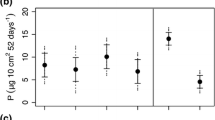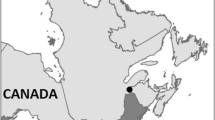Abstract
Douglas-fir trees about 21 years old and growing on a poor site were thinned and fertilized causing accelerated growth. The characteristics of the wood across the 30-year age span were studied for 7 trees from the treated plot. Four trees of nearly uniform ring growth were also studied for some characteristics. Radial and tangential tracheid diameters, tracheid length and percent latewood were correlated quite well with log of age, coefficients ranged from 0.76 to 0.88 on pooled data. All tracheid dimensions when correlated with log of age gave high coefficients on a within-tree basis. The strongest relationship in all age-related factors was between 0 and 12 to 14 years. Specific gravity increased with age in all trees to about 16 to 18 years, then leveled off.
Fertilization and thinning caused immediate production of lower density wood with somewhat lower percent latewood, a slight decrease in tracheid diameter tangentially but slightly greater radially, and a small decrease in tracheid length. The effects were mainly in the first 3 to 4 years after treatment, then there was recovery to normal wood density and cell dimensions. Wood from the trees of uniform growth showed no significant change over the same time period in percent latewood, specific gravity, and tracheid length.
Similar content being viewed by others
References
Dinwoodie, J. M. 1963. Variation in tracheid length in Picea sitchensis (Carr.), Spec. Rep. For. Prod. Res., No. 16, London.
Drow, J. T. 1957. Relationship of locality and rate of growth to density and strength of Douglas-fir. U.S. Forest Service, Forest Prod. Lab. Rept. 2078, 56pp.
Duffield, J. W. 1964. Tracheid length variation patterns in Douglas-fir and selection of extreme variants. TAPPI 47 (2): 122–124
Erickson, H. D., Lambert, G. M. G. 1958. Effects of fertilization and thinning on chemical composition, growth, and specific gravity of young Douglas-fir. For. Science 4: 307–315.
Gerry, E. 1916. Fiber measurements studies. A comparison of tracheid dimensions in longleaf pine and Douglas-fir with data on the strength and length, mean diameter and thickness of wall of tracheids. Science 43: 360.
Harrison, A. T. 1963. The effect of sudden increase in growth rate upon wood morphology of Douglas-fir. M. F. Thesis, College of Forest Resources, University of Washington, Seattle.
Kennedy, R. W. 1961. Variation and periodicity of summerwood in some second-growth Douglas-fir. TAPPI 44 (3): 161–166.
Knigge, W. 1962. Untersuchungen über die Abhängigkeit der mittleren Rohdichte nordamerikanischer Douglasienstämme von unterschiedlichen Wuchsbedingungen. Holz Roh-Werkstoff 20: 352–360.
McKimmy, M. D. 1966. A variation and heritability study of wood specific gravity in 46-year old Douglas-fir from known seed sources. TAPPI 49 (12): 542–549.
Megraw, R. A., Nearn, W. T. 1972. Detailed DBH density profiles of several trees from Douglas-fir fertilizer/thinning plots. Proc. symposium on the effect of growth acceleration on the properties of wood (Nov. 10–11, 1971), U.S. For. Prod. Lab and API-TAPPI Res. Liaison Com. to FPL. pp. G-1 to G-24.
Paul, B. H. 1963. The application of silviculture in controlling the specific gravity of wood. U.S.D.A. For. Serv., Tech. Bull. 1288. 97 pp.
Sastry, C. B. R. 1967. Some effects of fertilizer application on wood properties of Douglas-fir (Pseudotsuga Menziesii (Mirb.) Franco). M.S. Thesis, University of British Columbia.
Siddiqui, K. M., Gladstone, W. T., Marton, R. 1972. Influence of fertilization on wood and pulp properties of Douglas-fir. Proc. symposium on the effect of growth acceleration on the properties of wood (Nov. 10–11, 1971), U.S. For. Prod. Lab and API-TAPPI Res. Liaison Com. to FPL. pp. C-1 to C-18.
Smith, D. M. 1956. Effect of growth zone on specific gravity and percentage of summerwood in wide-ringed Douglas-fir. U.S. For. Serv., For. Prod. Lab. Rept. 2057, 9pp.
Wellwood, R. W., Smith, J. G. H. 1962. Variation in some important qualities of wood from young Douglas-fir and hemlock trees. University of British Columbia, Fac. of For. Res. Pap. No. 50.
Author information
Authors and Affiliations
Additional information
The research was financed by funds from State of Washington Initiative 171, Institute of Forest Products and the College of Forest Resources, University of Washington, Seattle.
Rights and permissions
About this article
Cite this article
Erickson, H.D., Harrison, A.T. Douglas-fir wood quality studies part I: Effects of age and stimulated growth on wood density and anatomy. Wood Science and Technology 8, 207–226 (1974). https://doi.org/10.1007/BF00352024
Received:
Issue Date:
DOI: https://doi.org/10.1007/BF00352024




